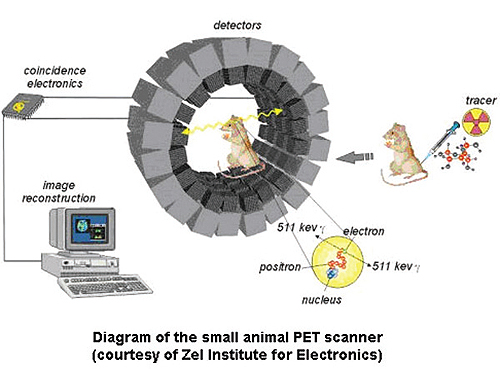In the study of human diseases and potential treatments, small animal models play a crucial role in bridging the gap between in vitro and in vivo studies. When considering imaging techniques for small animal studies, positron emission tomography (PET) is well suited to the measurement of highly specific molecular interactions such as glucose uptake and target-receptor binding. Small animal PET tomography scanners are constructed specifically for imaging living subject rodents for pre-clinical research and clinical diagnostics and to enable new drug discovery in academic and pharmaceutical research.
Large aperture rotary tables are a crucial part of such designs. The Planar ServoRing Series of rotary tables from IntelLiDrives helps researchers in academia, pharmaceutical companies and contract research organizations develop medical devices and techniques to support such research with fully conscious and mobile rodents without the added effects of anesthesia.
Most current research and commercial small animal SPECT (single photon emission computed tomography) scanners use pinhole collimation with magnification to achieve sub-millimeter spatial resolution. Many designs have multiple detectors and multiple pinholes per detector to improve system sensitivity and overall image quality. Some commercial hybrid scanners integrate SPECT detectors with high-resolution x-ray computed tomography (CT) detectors to generate multi-modality images with co-registered molecular (SPECT) and anatomic (CT) information. These current designs have limitations caused by non-ideal vertical orientation for animal imaging and can potentially interfere with the animal’s physiology and the distribution of the SPECT radioactive pharmaceuticals.
To solve these problems, the latest generation scanner architecture use large aperture rotary tables to independently rotate gamma cameras and detached pinholes collimators. In these scanners the animal is imaged in a horizontal orientation and the rotary table large center aperture allows un-restrained animal moves in the axial direction through the aperture relative to the rotating gamma camera detectors and collimator.
The center aperture of the rotary tables also allows a large trans-axial field of view in the scanning instrument and the ability to obtain sub-millimeter imaging resolution.
Such scanners use the Planar ServoRing models PSR300 and PSR300MHS with respective center apertures of 115 mm and 145 mm. They have zero backlash and are significantly faster than wormgear rotary actuators and have no gear wear, gear vibration or noise. The rotary stages maintain system accuracy and repeatability over time and allow researchers to obtain sub-millimeter resolution images with high rates of image acquisition and reconstruction. Direct-drive motor design has all of the advantages of a brushless motor with no brushes to wear out, no gear trains to maintain and high acceleration and high speeds. A precision encoder built into the rotary tables allows for synchronization with a linear transport animal bed.
IntelLiDrives, Inc.
www.intellidrives.com




Leave a Reply
You must be logged in to post a comment.